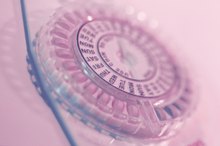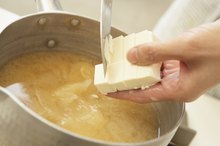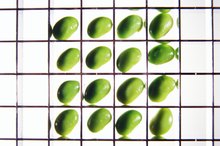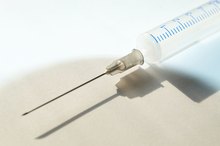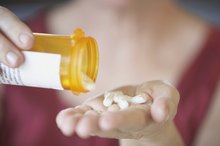What does fact checked mean?
At Healthfully, we strive to deliver objective content that is accurate and up-to-date. Our team periodically reviews articles in order to ensure content quality. The sources cited below consist of evidence from peer-reviewed journals, prominent medical organizations, academic associations, and government data.
- FDA: Bio-Identicals: Sorting Myths from Facts
- Harvard Health Publications: What are bioidentical hormones?
The information contained on this site is for informational purposes only, and should not be used as a substitute for the advice of a professional health care provider. Please check with the appropriate physician regarding health questions and concerns. Although we strive to deliver accurate and up-to-date information, no guarantee to that effect is made.
Over-the-Counter Estrogen Creams
Over-the-counter estrogen creams typically contain bio-identical, or plant-based estrogen called phytoestrogen. As with prescription creams, they are supposed to relieve common symptoms of menopause, such as hot flashes, vaginal dryness and mood swings. The American College of Obstetricians and Gynecologists cautions that there has been insufficient research on the effectiveness and safety of over-the-counter estrogen creams, and they are not regulated by the FDA. Discuss using over-the-counter hormone products with your medical provider.
If you are experiencing serious medical symptoms, seek emergency treatment immediately.
Bio-Identical Hormone Creams
Bio-identical hormone creams are often marketed as bio-identical hormone replacement therapy (BHRT) 1. Bio-identical hormone creams are often compounded with estrogen, estriol or phytoestrogen, progesterone and androgen. Estriol had not yet been FDA-approved in 2010, although it is not illegal to dispense it over the counter. The FDA cautions that BHRT is not a recognized medical term, but a marketing phrase. It advises that consumers should be cautious about claims that these creams are safer than prescription estrogen creams, and that they may carry the same health risks and side effects as creams your doctor prescribes. In 2008, the International Academy of Compounding Pharmacists issued a press release stating that women should be given the choice to purchase over-the-counter bio-identical hormone creams, and that estriol was legal, safe and effective.
- Bio-identical hormone creams are often marketed as bio-identical hormone replacement therapy (BHRT) 1.
- In 2008, the International Academy of Compounding Pharmacists issued a press release stating that women should be given the choice to purchase over-the-counter bio-identical hormone creams, and that estriol was legal, safe and effective.
Estriol Cream
What Other Hormones Are Available Besides Prempro?
Learn More
Although estriol isn't FDA-approved for prescription use, you can still buy estriol creams legally over the counter. Estriol is a relatively weak form of estrogen, and according to an article on the Women's Health website, it has fewer side effects than other estrogen treatments. When applied vaginally, estriol cream can reduce vaginal dryness. Women's Health reports that a study also indicated that estriol cream may significantly improve the appearance of facial skin, reducing the size of pores and fine wrinkles. It's also been used in Europe to treat menopausal symptoms.
- Although estriol isn't FDA-approved for prescription use, you can still buy estriol creams legally over the counter.
- Women's Health reports that a study also indicated that estriol cream may significantly improve the appearance of facial skin, reducing the size of pores and fine wrinkles.
Soy Cream
Soybeans contain phytoestrogens, a weak form of plant-based estrogen 1. While dietary soy in the form of food or supplements may be helpful in reducing menopausal symptoms, there is not enough evidence yet to prove that they are effective when applied as a cream or gel. However, soy estrogen cream is widely available over the counter. It is often combined with wild yam, which contains natural progesterone and is thought to complement the estrogen.
- Soybeans contain phytoestrogens, a weak form of plant-based estrogen 1.
- While dietary soy in the form of food or supplements may be helpful in reducing menopausal symptoms, there is not enough evidence yet to prove that they are effective when applied as a cream or gel.
Related Articles
References
- Harvard Health Publications: What are bioidentical hormones?
- Ali ES, Mangold C, Peiris AN. Estriol: emerging clinical benefits. Menopause. 2017;24(9):1081-1085. doi:10.1097/GME.0000000000000855
- Rueda C, Osorio AM, Avellaneda AC, Pinzón CE, Restrepo OI. The efficacy and safety of estriol to treat vulvovaginal atrophy in postmenopausal women: a systematic literature review. Climacteric. 2017;20(4):321-330. doi:10.1080/13697137.2017.1329291
- Raz R, Stamm WE. A controlled trial of intravaginal estriol in postmenopausal women with recurrent urinary tract infections. N Engl J Med. 1993;329(11):753-6. doi:10.1056/NEJM199309093291102
- Capobianco G, Donolo E, Borghero G, Dessole F, Cherchi PL, Dessole S. Effects of intravaginal estriol and pelvic floor rehabilitation on urogenital aging in postmenopausal women. Arch Gynecol Obstet. 2012;285(2):397-403. doi:10.1007/s00404-011-1955-1
- Voskuhl RR, Wang H, Wu TC, et al. Estriol combined with glatiramer acetate for women with relapsing-remitting multiple sclerosis: a randomised, placebo-controlled, phase 2 trial. Lancet Neurol. 2016;15(1):35-46. doi:10.1016/S1474-4422(15)00322-1
- electronic Medicines Compendium. Ovestin 1 mg cream. Updated April 2019.
- Holtorf, K. The bioidentical hormone debate: are bioidentical hormones (estradiol, estriol, and progesterone) safer or more efficacious than commonly used synthetic versions in hormone replacement therapy?. Postgrad Med. 2009 Jan;121(1):73-85. doi:10.3810/pgm.2009.01.1949
- Cano A1, Estévez J, Usandizaga R, Gallo JL, Guinot M, Delgado JL, Castellanos E, Moral E, Nieto C, del Prado JM, Ferrer J. The therapeutic effect of a new ultra low concentration estriol gel formulation (0.005% estriol vaginal gel) on symptoms and signs of postmenopausal vaginal atrophy: results from a pivotal phase III study. Menopause. 2012. 19(10):1130-9. doi:10.1097/gme.0b013e3182518e9a
Writer Bio
Stevie Donald has been an online writer since 2004, producing articles for numerous websites and magazines. Her writing chops include three books on dog care and training, one of which won a prestigious national award in 2003. Donald has also been a painting contractor since 1979, painting interiors and exteriors.

